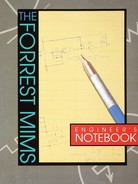INTRODUCTION
Since my student days at Texas A&M University I have kept a series of laboratory notebooks. In these notebooks I record details about experiments, measurements, and new ideas. Also included are many electronic circuit diagrams. Dave Gunzel, formerly the director of technical publications at Radio Shack, took an interest in my notebooks in the mid-1970s and suggested that Radio Shack might someday want to publish a book of electronic circuits based on their hand-drawn format. Several years later, Radio Shack assigned me to produce Engineer’s Notebook, a 128-page book of electronic circuits. The book soon became a Radio Shack bestseller. As new integrated circuits were added to Radio Shack’s product line and others were dropped, I revised the book as necessary. Later, Radio Shack authorized me to do an edition of the book for McGraw-Hill.
This revised edition for LLH Technology Publishing represents the best and most interesting circuits from all previous editions.
The integrated circuits described in this book remain among the most popular ever introduced. Most of them are readily available from Radio Shack, electronic parts suppliers, and mail order dealers. Magazines such as Radio-Electronics carry ads from mail-order IC dealers. A few of the chips are specialized and finding sources for them may be more difficult. Four of the devices—the CEX-4000, S50240, PCIM-161, and SAD-1024—may be available only from dealers in surplus and discontinued ICs. However, the overwhelming majority of chips described in this book are readily available from many different sources. In fact, prices for some of the more common devices have fallen substantially since the first edition of this book. Some are available today for pennies!
Most of the part numbers given for the integrated circuits in this book are generic, and various manufacturers may add additional letters or numbers or even use a completely different number. For example, the 4011 is a quad of CMOS NAND gates. An “A” suffix (4011A) means this chip can operate from a 3- to 12-volt supply. A “B” suffix (4011B) means the chip can operate from 3- to 18-volt supply. The high-voltage version of the chip is by far the most common. National Semiconductor adds a CD prefix to its versions of the 4011B (CD4011B), while Motorola adds an MC1 prefix (MC140111B). Nevertheless, both chips are functionally identical.
For additional information about chip identification and specifications, see the data books published by the various integrated circuit manufacturers. These books are available directly from manufacturers of integrated circuits and from industrial supply companies that represent integrated circuit manufacturers. They are also available from some mail-order electronics parts dealers.
